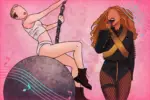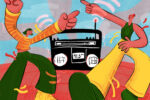On May 24, 2018, Chris released her new cleverly titled single, “Girlfriend.” Though this is Chris’ first single under her new name, Héloïse Letissier has been considered a pop icon since the release of her (at the time) self-titled album “Christine and the Queens.” Letissier was known under her previous stage name “Christine and the Queens” for four years.
Just weeks ago, she re-introduced herself as “Chris” with the release of the new song and subsequent video. As explained in an interview with BBC’s Annie Mac, Chris states that her new persona is “an evolution of Christine,” “a 2.0 version.” Beyond “Girlfriend,” Letissier promises yet another experimental album that pushes boundaries and questions societal gender binaries.
Lyrically and melodically, “Girlfriend” is a clever and nuanced masterpiece. The song opens with Dám-Funk coolly stating “Chris,” as a way to assert Letissier’s bold presence and evolved identity. In the music video, Chris is first shown seated on a steel beam, overlooking an urban horizon.
A dove rests on her shoulder, which she quickly and gently shoos away. With this minute gesture, Chris sets the tone for the video and re-asserts one of her main goals: to shoo away the expectations of femininity and softness that society has thrust upon her.
She then enters the screen purposefully. She is walking across the steel beams and platforms that make up the skeleton of a skyscraper, beautifully back-lit by the sunset. Clad in an orange crop top, high-waisted jeans, chunky sneakers and understated jewelry, Chris is an androgynous powerhouse. Her physical form glistens in the waning sunset as she prepares to further defy the gender binary.
“Girlfriend’s” first verse aptly explains Chris’ public debut. In accordance with the new figure she has become, Chris sings that “boys are loading their arms / girls gasp with envy,” and asks, “for whom are they mimicking endlessly?” As an answer to their questions, Chris assures watchers that the figure before them is the artist formerly known as Christine and the Queens, with the “same old sadness in small lumps on [her] jaw.”
Whilst singing this brief melodic monologue, Chris is shown strutting past male figures. She flicks a man’s hat off, then playfully and lightly whacks him in the head. Chris’ presence has been made clear as she has earned the respect and the attention of the other individuals in the video.
Flaunting her muscles, Chris stands and presents herself for the duration of the video. In a few West Side Story-esque dance interludes, she appears at the center of a pyramid formation of dancers, acting as their fearless leader. As the dancing evolves, Chris seems to thrive as the star of a sort of androgynous boy band. The ebb and flow of the choreography in “Girlfriend” showcases variations on famous representations of masculinity.
Chris brilliantly creates and dances outside of the box that she, as a woman, has historically been confined to. As she so clearly explains in the song’s chorus, she won’t be a “girlfriend,” but she will be “your lover.” Chris will not be defined by passive roles that are expected of her. Again and again, the artist proves that she will actively forge her own path by defining herself through her own unique expression of her personhood.
In the midst of the second verse, one of the dancers that previously flanked Chris approaches her on the song’s line, “fuck is you?” symbolically questioning her identity and authority. In her comments with Genius, she describes being asked these sorts of questions by “bird-dogs,” a symbol that the artist has used in earlier songs. Triumphantly, Chris brushes off the dancer, throwing back “fuck is me?… fuck is you,” asserting that her self-expression should not be questioned of that of others is not as well.
Chris’ lyric and choreographic identification of this gross double standard points at many comments she’s made about her own gender expression. In an interview with Genius, Letissier explained that she “initially set out to smash against macho culture,” but then “became obsessed with this idea of the macho man,” while “still being a woman.” Evidently, “Girlfriend” asks “what does it mean if [Chris is] this figure, and… a woman?”
The video concludes with a vast scene of Chris, again surrounded by her troupe of macho dancers, balancing on a suspended steel beam. Chris’ fearlessness in suspension seems to answer the question she aims to pose with the song’s video: if she is a macho woman (or, if she is whoever she wants to be) valiantly defying expression, she is infinitely powerful. Chris exhibits a particular strength that is uniquely possessed because she fashioned it herself.
This fluid and super-individual that Letessier portrays is nothing new for previous Christine and the Queens fans. An earlier exploration of Chris’ macho-woman concept was showcased by the artist in her song, “iT,” off “Christine and the Queens.” The track begins vaguely, she hints that “with iT” she becomes “the death Dickinson feared,” and “a red admiral on this ship.” Early on, it is evident that with whatever Chris is toting, she feels powerful and tenacious.
The song’s chorus immediately reveals that “iT” is some sort of sense of masculinity. “I’ve got it//I’m a man now,” Chris sings. Further expressing her ownership, she states “and I won’t let you steal it, I bought it for myself//I’m a man now.” Chris possesses her own form of masculinity, to which she seems to attribute a personal sense of power. Beyond that, Chris’ lyrics seem to indicate that she feels she earned this sense of power.
When taking a deeper look, that sense of power seems to be less focused on its masculine elements, and more tied to Chris’ goals and bravery to dare to genderbend. In her recent interview with Annie Mac, Chris explained that she wants to “escape definition,” and that “queer is not a box… queer is escaping boxes.” “iT” could be her defiance in general, rather than her machismo.
Chris’ personal queerness, “iT” in this case, is disputed by the aforementioned bird-dogs. Seeming to liken the media and those who question her gender identity to hunting dogs used to hunt small animals, Chris sings that “the bird-dogs” “pulling [her] hair,” exclaim that “she wants to be a man” but that “she lies.” “She draws her own crotch by herself / but she’ll lose / because it’s a fake.” In a direct reference to her unique performance of her own masculinity, Chris acknowledges that some cannot understand her and see her as a falsity.
Combating their inability to comprehend her, Chris sings “I’ve got it / I’m a man now / And there’s nothing you can do to make me change my mind.” In this portrayal of an argument concerning her gender identity, Chris describes those who are against her as feeling that her masculinity and power cannot be real because she fashioned it herself.
However, Chris’s point with “iT” seems to be that, in fact, because she created her own sense of masculinity and power, it is staunchly real. It’s legitimacy and authenticity lies in the fact that it is uniquely hers, and her own creation.
Chris says pic.twitter.com/EEJA3v6WmY
— Red 🦋 (@QueensChristine) May 4, 2018
Chris defines feminism as “giving everyone the potential to be multifaceted.” In her recent BBC interview, Chris finds freedom in performing and existing in ways that are as varied as she wants to be. Via Twitter, she states that her “eroticism is precisely what sets [her] free of those skimpy limits of the gender [she is] assigned to.”
Her ambiguity is her strength, and fans certainly cannot wait to see what sort of musical identity Chris escapes to next.

















